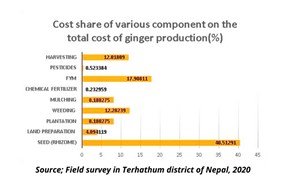Socio-economic analysis of ginger production in Terhathum district, Province no. 1, Nepal
Abstract
Terhathum is one of the major ginger-producing districts in Nepal. This study with the objective of analyzing the socio-economic status of ginger growing farmers in the Terhathum district investigates the production economics of ginger (Zingiber officinale Rose.) and the socioeconomic status of ginger producing farmers. The semi-structured interview schedule was administered to interview randomly selected commercial ginger-producing households in Myanglung municipality, Phedap rural municipality, and Menchhayayem rural municipality with 35, 39, and 17 respondents from each of the locations respectively. The overall productivity of ginger in the study area was found to be 19.3 MT/ha. The major cost-share for ginger production was found to be held by rhizomes used in the plantation (40.01%). The results indicated that ginger production was a profitable enterprise in the study area with an average B: C ratio of 3.77. The Cobb-Douglas production function indicated that ginger production exhibit increasing returns to scale at a decreasing rate. Rhizome quantity and amount of organic manure applied in the field played a major role in increasing the gross margin of the production. The goodness of fit was 52.3% with a return to scale of 0.714. Indexing technique identified incidence of diseases and pests and the instability of price as the major problems associated with production and trade of ginger. Overall, the study revealed that ginger production was a profitable and potential agriculture enterprise for the study area.
Keywords:
B/C ratio, Cobb-Douglas, Gross margin, Production factorDownloads
References
Acharya, N., Acharya, B., Dhungana, S., & Bist, V. (2019). Production economics of ginger (Zingiber officinale Rose.) in Salyan district of Nepal. Archives of Agriculture and Environmental Science, 4(4), 424–448,https://doi.org/10.26832/24566632.2019.040408
Adhikari, B. P. (2016), Nepal ginger profile: an assessment of commercial ginger cultivated in Nepal, Samarth- NMDP
ANSAB. (2011, August). Value chain/ market analysis of the ginger sub-sector in Nepal. USAID. https://ansab.org.np/storage/product/nepal-neat-subsector-market-analysis-ginger-aug-2011-1579689425.pdf
Aryal, M. (2022, February 15). Ginger farmers face hard times after market crashes. The Kathmandu Post. https://kathmandupost.com/money/2022/02/15/ginger-farmers-face-hard-times-after-market-crashes
Asia Network for Sustainable Agriculture and Bioresources. (2011, July). A report on value chain analysis of ginger subsector in Nepal. High Value Agriculture Project in Hill and Mountain Areas (HVAP). https://www.ansab.org.np/storage/product/hvap-vca-reports-ginger-1579689954.pdf
Chen, I. N., Chang, C. C., Ng, C. C., Wang, C. Y., Shyu, Y. T., & Chang, T. L. (2008). Antioxidant and antimicrobial activity of Zingiberaceae plants in Taiwan. Plant foods for human nutrition (Dordrecht, Netherlands), 63(1), 15–20, https://doi.org/10.1007/s11130-007-0063-7
Collier, P. (2007). The Bottom Billion: Why the Poorest Countries are Failing and What Can Be Done About It (1st ed.). Oxford University Press.
Dahal, B., & Rijal, S. (2020). Ginger value chain analysis: A case of smallholder ginger production and marketing in hills of central Nepal. Agricultural Science and Technology, 12(1), 31–36. https://doi.org/10.15547/ast.2020.01.006
Ettanil, J., Kandiannan, K., Prasath, D., & Pervez, R. (2015, November). Ginger (extension pamphlet). ICAR-Indian Institute of Spices Research.
https://doi.org/10.13140/RG.2.1.3903.7681
Ezra, D., Akinola, M., Banta, A., Makarau, S., & Hussaini, A. (2017). Socio-economic assessment of ginger production in Jaba local government area of Kaduna state, Nigeria. Asian Journal of Agricultural Extension, Economics & Sociology, 15(2), 1–11, https://doi.org/10.9734/ajaees/2017/28949
Ghimire, A. (2020, November). Nepal brief; Nepal Malaysia corridor. Migration for Development and Equality. https://www.mideq.org/en/resources-index-page/nepal-brief/
GOK. (2011). Report on cost of cultivation of important crops in Kerala (2010-11.) Government of Kerala. Department of Economics & Statistics. Thiruvananthapuram. http://www.ecostat.kerala.gov.in/images/pdf/publications/Cost_of_Cultivation/data/cost1112.pdf
Gurung, B., Regmi, R., Paudel, A., Paudel, U., Paudel, A., & Shrestha, S. (2021). Profitability, marketing, and resource use efficiency of ginger production in Rukum west, Nepal. Archives of Agriculture and Environmental Science, 6(4), 426-435, https://dx.doi.org/10.26832/24566632.2021.060403
Kandiannan, K., Thankamani, C. K., Shrinivasan, V., & Prasath, D. (2016, November). Effect of planting geometry on yield performance of ginger (Zingiber officinale) intercropped with maize (Zea mays). 1279–1280,.
Karki, S. (2022, February 2). Nepalis moving from mountains to plains. Nepali Times. https://www.nepalitimes.com/banner/nepalis-moving-from-mountains-to-plains/
Khanal, K. (2018). Factors Affecting and marketing chain of ginger in Salyan District, Nepal. International Journal of Applied Sciences and Biotechnology, 6 (2): 127-131, https://doi.org/10.3126/ijasbt.v6i2
Mahat, S., Sapkota, S., Sapkota, S., & Katuwal, K. (2019). Factors affecting ginger production in surkhet district, Nepal. International Journal of Applied Sciences and Biotechnology, 7(2), 270, https://doi.org/10.3126/ijasbt.v7i2.24650
Major Export Products - NTIP. (2020). TEPC. https://nepaltradeportal.gov.np/web/guest/major-commodity?p_p_id=commodityportlet_WAR_tepc&p_p_lifecycle=0&p_p_state=normal&p_p_mode=view&_commodityportlet_WAR_tepc_param=getDetail&id=4
Ministry of Federal Affairs and General Administration. (2020). Ward profile. Phedap Rural Municipality. https://www.phedapmun.gov.np/ward-offices
Ministry of Federal Affairs and General Administration. (2020a). Ward no. 6. Menchhayayem Rural Municipality. https://www.menchhayayemmun.gov.np/content/%E0%A4%B5%E0%A4%BE%E0%A4%B0%E0%A5%8D%E0%A4%A1-%E0%A4%A8%E0%A4%82-%E0%A5%AC
Mmasa, J., & Mhagama, J. (2017). Social-Economic factors influencing ginger (zingiber officinale) productivity among smallholders growers in tanzania - case of same district. Journal of Economics and Sustainable Development, 8(8), 22.
MOAD (2018). Statistical information on Neplese Agriculture 2017/2018. Ministry of Agriculture and Development. Singhadurbar, Kathmandu Nepal.
Neupane, J., Ghimire, S., Chalise, D., & Devkota, D. (2019). Socio-Economic Analysis of Ginger Production in Surkhet District of Nepal. Acta Scientific Agriculture, 3(11), 28–33, https://doi.org/10.31080/asag.2019.03.0680
Poudel, R., Regmi, P., Thapa, R., Gc, Y., & Karki, G. (2015). Socio-economic aspects of ginger producers in the western hills of nepal. Nepalese Journal of Agricultural Sciences, 13(1), 49–51, https://nirkrakauer.net/papers/NJAS_2015.pdf#page=25
Poudel, R., Regmi, P., Thapa, R., Gc, Y., & Kc, D. (2018). Economic analysis of ginger cultivation in selected locations of Nepal. Bangladesh Journal of Agricultural Research, 42(4), 681–691, https://doi.org/10.3329/bjar.v42i4.35795
Vasala, P. (2012). Ginger. In K. Peter, Handbook of Herbs and Spices (Second ed.,pp 319-335). Oxford: Woodhead Publishing Series in Food Science, Technology and Nutrition.

Published
How to Cite
Issue
Section
Copyright (c) 2022 Agriculture and Environmental Science Academy

This work is licensed under a Creative Commons Attribution-NonCommercial 4.0 International License.

